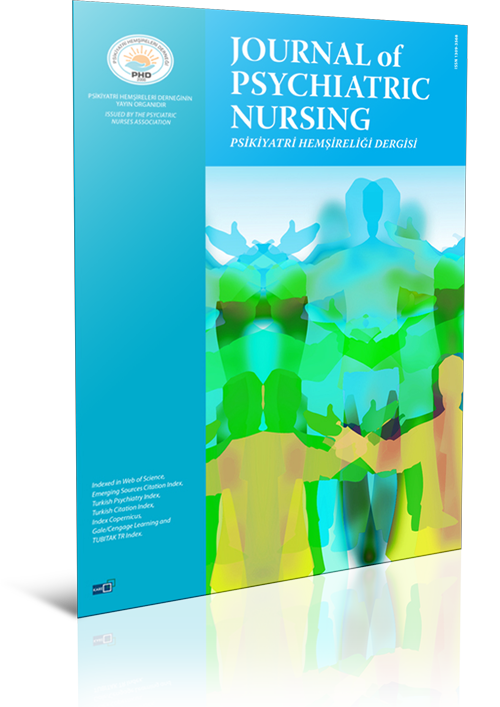
Volume: 10 Issue: 2 - 2019
| 1. | Frontmatter Pages I - III |
| EDITORIAL | |
| 2. | Editorial Nurhan Eren, Nazmiye Kocaman Yıldırım Page IV |
| RESEARCH ARTICLE | |
| 3. | How do you prefer to be addressed?: The relationship between forms of address in nurse-patient communication and nursing care Buket Şimşek Arslan, Ahmet Göktaş, Kadriye Buldukoğlu doi: 10.14744/phd.2019.95867 Pages 89 - 95 INTRODUCTION: The aim of this study is to examine the relationship between the forms of address used between nurses and patients and their effect on nursing care in Turkish culture. METHODS: This descriptive study was completed with 186 inpatients at Akdeniz University Hospital in Antalya, Turkey. A personal information form and two scales concerning nursing care were used. The personal information form asked which forms of address the patients used with nurses. The data were analyzed using descriptive statistics, normality tests, the chi-square test and the Mann-Whitney U test. RESULTS: The mean age of the patients was 50.9±16.5, and 50% were female. The study found that 54.9% of the patients were hospitalized for chronic disease, and 39.8% has been in treatment for 2-5 days. The formal form of address was used most by both nurses (59.1%) and patients (69.4%). Two-thirds of the patients (66.1%) preferred to be addressed informally by nurses. There were statistically significant differences between forms of address and age, education, marital status, number of children and occupation. There were statistically significant relationships between the Scale of Patient Perception of Hospital Experience with Nursing, the Nursing Care Behaviors Inventory-24 and forms of address (p<0.05). DISCUSSION AND CONCLUSION: The formal form of addresses is usually used in communication between patients and nurses. However, most patients want nurses to address them informally. As patients age increases, nurses use of informal address also increases. The study also determined that the patients who were addressed informally were more satisfied with their nursing care. |
| 4. | Examination of the knowledge and practices of nurses about consultation liaison psychiatry nursing Serap Yıldırım, Ebru Şimşek, Koza Geridönmez, Şerife Basma, Übeyit Vurak doi: 10.14744/phd.2019.21548 Pages 96 - 102 INTRODUCTION: This study was conducted to examine the knowledge and practices of nurses in CLP nursing. METHODS: The average age of the nurses participating in the study was 33.94±5.69, 91.2% of them were women, all of them had license degrees, 70.6% were in internal medicine clinics, 29.4% were in surgical units, 42.6% were in clinics and 31.6% had worked between one and five years. The study determined that 65.4% of the nurses encountered a patient suffering from mental distress, 32.4% encountered a health professional suffering from mental distress, and 44.9% had difficulties while giving care to patients suffering from mental distress. The study found that 44.9% of the nurses could define biopsychosocial care, 27.2% could define psychosocial care and 96.3% considered psychosocial care to be important. Of the nurses, 4.4% knew the definition of CLP nursing, 94.9% had not worked with consultation liaison psychiatric nurses before, and 74.3% needed the CLP nurse to work with them in the clinic. RESULTS: The average age of the nurses participating in the study was 33.94±5.69, 91.2% of them were women, all of them had license degrees, 70.6% were in internal clinics, 29.4% were in surgical units,42.6% were in clinics and 31.6% were in total for 1 to 5 years working. It was determined that 65.4% of the nurses were confronted with the patients suffering from mental distress, 32.4% were confronted with the health professional suffering from mental distress, and 44.9% had difficulties while giving care to the patients suffering from mental distress. It was found that 44.9% of the nurses could define biopsychosocial care, 27.2% could define psychosocial care, and 96.3% were found psychosocial care to be important. It was determined that 4.4% of the nurses who participated in the study knew the definition of consultation liyezon psychiatric nursing, 94.9% had not worked with the consultation liyezon psychiatric nurses before, and 74.3% had needed the consultation liyezon psychiatric nurse in the clinic they were studying. DISCUSSION AND CONCLUSION: The study concluded that the nurses had difficulty in giving care to patients suffering from mental distress, they needed support from a professional in this field, and they needed information regarding biopsychosocial care, psychosocial care, consultation-liaison psychiatric nursing. In light of these results, it has been proposed to open and disseminate master programs for the training of consultation-liaison psychiatric nurses to meet the need. |
| 5. | End-of-life psychodrama: Influencing nursing students communication skills, attitudes, emotional intelligence and self-reflection Audrey Marie Beauvais, Azize Atli Özbaş, Kathleen Wheeler doi: 10.14744/phd.2019.96636 Pages 103 - 110 INTRODUCTION: This study aimed to determine if nursing students communication skills, attitudes towards caring of the dying patients, emotional intelligence, and reflection change after a psychodrama group intervention. METHODS: A pre/posttest design was utilized with a psychodrama intervention group and a control group during a Mental Health Nursing course. The study was set in Fairfield University (USA) with approximately 390 traditional undergraduate nursing students. A convenience sample of eighty-four nursing students was invited to participate in the study. Thirty-eight of those students participated in the intervention group and 41 participated in the control group. All participants in the control and intervention groups were asked to complete the demographic information, process recordings, Frommelt Attitude Toward Care of the Dying Scale, Mayer-Salovey-Caruso Emotional Intelligence Test, and Self Reflection and Insight Scale at the beginning and end of the psychodrama intervention. RESULTS: There was a statistically significant difference in communication skills, attitudes towards the care of the dying, and self-reflection between the intervention and control groups. There was no statistical difference in total and branch emotional intelligence between the intervention group and control groups. DISCUSSION AND CONCLUSION: The study highlighted the value of psychodrama as a strategy that can enhance nursing students communication skills, attitudes towards dying patients, and reflection. Such an intervention has the potential to ultimately improve the quality of care for end-of-life patients and their families. |
| 6. | The relationship between psychological resilience and life satisfaction in COPD patients Gülşen Kılınç, Erman Yıldız, Funda Kavak doi: 10.14744/phd.2019.60362 Pages 111 - 116 INTRODUCTION: This study was carried out descriptively in order to determine the relationship between psychological resilience and life satisfaction in COPD. METHODS: The study was conducted with 114 COPD patients who were treated in a university hospitals respiratory services department between July 2016 and June 2017. Data were obtained with the Personal Information Form, Resilience Scale for Adults and Life Satisfaction Inventory. Descriptive statistics, independent samples t-test, Kruskal-Wallis Variance, Mann-Whitney U Test, Analysis of Variance and Analysis of Regression were used in the evaluation of data. RESULTS: The mean age of the patients was 70.08±10.62, the majority (77.1%) were male, 80.6% were married, 86.8% were unemployed, 59.7% had graduated primary school. Total score of Resilience Scale for Adults was 116.43±19.78 and Life Satisfaction Inventory was 18.70±6.72. A significant positive correlation was determined between resilience and life satisfaction. Psychological endurance predicts life satisfaction significantly and accounts for 65% of the total variance associated with psychological endurance. DISCUSSION AND CONCLUSION: According to the results of the study, the psychological endurance levels and life satisfaction of COPD patients were found to be high. When resilience of patients increased, life satisfaction was higher. |
| 7. | Investigation of the relationship between early stage maladaptive schemas and anger levels in people with substance-use disorders Bilge Dilek Soyaslan, Celale Tangül Özcan doi: 10.14744/phd.2019.87049 Pages 117 - 123 INTRODUCTION: This study was conducted as a case-control study to investigate the relationship between early stage maladaptive schemas and anger levels in people with and without substance-use disorders. METHODS: The sample for the investigation included a case group of 73 patients who presented to a military hospital mental health and diseases polyclinic and a control group of 75 current soldiers and rankers performing military service who presented to the same hospital. Sociodemographic Data Collection Form-1 was applied to the case group and Sociodemographic Data Collection Form-2 was applied to the control group, while the Young Schema Questionnaire Short Form-3 (YSQ-SF3), the State-Trait Anger Scale and the State-Trait Anger Expression Inventory were applied to both groups. For the evaluation of the data, the chi-square test, Mann Whitney U test and correlation analysis were used. RESULTS: In comparing the case group and control group in terms of sociodemographic characteristics, it was observed that, with the exception of intra-family relationships and family economic status levels, for which significant differences were seen (p<0.05), no statistically significant differences were found (p>0.05). When the schema domains of the case group and control group were evaluated, Disconnection, Impaired Autonomy, High Standards, and Impaired Borders schema domains and subscale components were significantly higher than those of the control group (p<0.05). Comparison of the anger styles between the case group and control group showed that those in the case group had significantly higher points in Trait Anger, Anger In and Anger Out than those of the control group (p<0.05). In the correlation analysis performed, a positive moderate relationship was found between Emotional Deprivation and the Self Sacrifice schema sub-scale and Anger In for the case group and control group, while a positive moderate relationship was also found between Approval Seeking, High Standards, Punitiveness and Other-directedness and Trait Anger, Anger In and Anger Out, but a negative weak relation with Anger Control. DISCUSSION AND CONCLUSION: Evaluation of the study data showed that the case group, which had substance-use disorders, had an excess of early stage maladaptive schemas, and there was a significant level of difference between the case group and control group in terms of anger levels. |
| 8. | Determining the burdens and difficulties faced by families with intellectually disabled children Serap Balcı, Hamiyet Kızıl, Sevim Savaşer, Şadiye Dur, Birsen Mutlu doi: 10.14744/phd.2018.05657 Pages 124 - 130 INTRODUCTION: This descriptive research was conducted with the aim of determining the difficulties families with intellectually disabled children face and their family burdens. METHODS: The research population consisted of the mothers of 220 children who are aged 0-18 and monitored at a Special Guidance and Research Center due to their intellectual disabilities. The sample group was composed of 160 mothers who consented to participate in the research. RESULTS: Of the children, 36.9% had mild, 43.1% had moderate, and 20% had severe mental retardation. Of the mothers, 48.8% reported they had no one with whom to share the care of the child. Mothers also reported that they felt disappointment (38.8%), bewilderment (48.1%), shock (31.3%), desperation (52.5%), anger (16.9%), guilt (14.4%). Of the mothers, 13.1% blamed others, 61.9% accepted the situation as an act of God, 12.5% had thoughts of committing suicide, and 28.1% suffered from depression. On the "Family Burden Assessment Scale (FBAS)," 7.5% of the mothers got low scores, and 92.5% got high scores. DISCUSSION AND CONCLUSION: This research found that most of the families felt anxious about the future, felt like their burden was too much to bear, and expected information and support from healthcare professionals. |
| REVIEW | |
| 9. | A telenursing practice for care of people with schizophrenia: Telephone intervention problem solving Esra Uslu, Kadriye Buldukoğlu, Lora Humphrey Beebe doi: 10.14744/phd.2019.75768 Pages 131 - 136 Schizophrenia makes it difficult for people to solve the problems they face in their daily lives. Thus, schizophrenic patients living in a community need special applications to cope with these problems. The Telephone Intervention Problem Solving (TIPS) has been developed by Beebe to serve as a solution for various daily problems of patients with schizophrenia, to offer them coping alternatives, to remind them to use these alternatives and to evaluate the effectiveness of these coping efforts. TIPS, which is conducted with weekly phone calls, is a telenursing practice based on the theory of planned behavior and conducted using problem solving process. Experimental studies conducted on this topic have shown that TIPS extends the time patients with schizophrenia spend in the community, and reduces the number of days spent and applications performed in rehospitalization process. It has also been found that this practice improves the psychiatric medication adherence and reduces the severity of psychiatric symptoms. TIPS was practiced within the context of a doctoral thesis for the first time in Turkey. After the practice, it was concluded that the practice protocol items included in the guideline can be easily used and that it is necessary to rework on only the fourth item. In light of this information, this review article aims to introduce TIPS to psychiatric nurses and to guide them to put TIPS into practice. |
| 10. | Nursing responsibilities and non-pharmacological approaches in delirium management Canan Karadas, Leyla Özdemir doi: 10.14744/phd.2019.81994 Pages 137 - 142 Delirium is a common clinical syndrome; characterized by rapid onset and fluctuating symptoms during the day. A decrease in functional capacity, an increase in length of stay at the hospital, and an increase in mortality are negative results seen in delirious patients. Therefore, patients should be assessed at least once a day in terms of delirium that may develop due to underlying factors. Because delirium monitoring does not contribute to improvement in delirium itself, delirium prevention and treatment methods are needed. Non-pharmacological approaches include re-orientation, reduction of environmental stimuli, early mobility, providing hydration and sleep hygiene. Frequently used nonpharmacological approaches in delirium management are easy to implement, cost effective and directly related to nursing care. However, few studies document information about which approaches are used or the content and effects of these approaches. This review aims to discuss non-pharmacological approaches used in the management of delirium and the nursing responsibilities based on recent literature. |
| 11. | The field of care work and habitus Bahanur Malak Akgün doi: 10.14744/phd.2018.19971 Pages 143 - 148 This article is intended to explain the Pierre Bourdieus concept of habitus to researchers concerned with patient-nurse interactions, nursing practices and nurses professional and individual selves and identities. It emphasizes both the field of care work and nurses personal characteristics. Nursing is a therapeutic interpersonal process that is intended to promote individuals wellbeing and health. However, very few studies have evaluated how it developed in a systematic way. Pierre Bourdieus concept of habitus can lead the way for nurses who would like to understand patient-nurse interactions, nursing practices and the field of care work. Habitus affects how nurses approach their patients, how they understand and interpret patient conditions and their needs. Therefore, habitus affects how nurses understand and interpret the status and care needs of patients under the circumstances including their individual characteristics. The field of care work is also a metaphor for a social site where nurses engage in care-related activities. Ultimately, nursing habitus is developed by both individual and structural factors that are complex and diverse. It affects nurses careers and motivation to provide services. Assessing patient-nurse interactions, nursing practices and nurses professional and individual self and identities in this way can affect the quality of care positively. |
| CASE REPORT | |
| 12. | Individualized rehabilitation program for a schizophrenic patient: a case report Sibel Coşkun doi: 10.14744/phd.2019.16013 Pages 149 - 154 Impaired functioning in schizophrenic patients and symptoms like social isolation and unwillingness to interact with others and drug side effects affect their quality of life. Therefore, the participation of schizophrenic patients in rehabilitation processes and activity programs is very important. In this case report, the problems and needs of a patient who was reluctant to join the activity program in the community mental health center were analyzed, and within the context of a family-specific, individually planned rehabilitation program, behavioral techniques were predominantly applied. When the 6-month period was evaluated, the patient's functioning and quality of life level had increased, his symptoms had decreased, and he had a greater level of participation in activities. From this case report, it can be concluded that it is beneficial to implement individual rehabilitation programs for chronic mental illness patients and to apply behavioral therapy methods. Moreover, specialist psychiatric nurses should take a more active role in rehabilitation and counselling programs. |


















